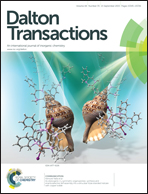Two-photon absorption properties and 1O2 generation ability of Ir complexes: an unexpected large cross section of [Ir(CO)2Cl(4-(para-di-n-butylaminostyryl)pyridine)]†‡
Abstract
The new complexes cis-[Ir(CO)2Cl(4-(para-di-n-butylaminostyryl)pyridine)] (1) and [Ir(cyclometallated-2-phenylpyridine)2(4,4′-(para-di-n-butylaminostyryl)-2,2′-bipyridine)][PF6] (3) were synthesized and fully characterized along with the known complex Ir(cyclometallated-2-phenylpyridine)2(5-Me-1,10-phenanthroline)][PF6] (2). Remarkably, complex 1, with an Ir(I) centre, displays fluorescence – as opposed to the phosphorescence typical of many Ir(III) complexes – with a modestly high quantum yield in solution, opening a new route for the design of iridium-based emitters which should not be limited to the +3 oxidation state. It is also characterized by an unexpectedly large two-photon absorption (TPA) cross section, an order of magnitude higher than that previously reported for Ir(III) or Pt(II) complexes. The great potential of cyclometallated Ir(III) complexes for photodynamic therapy was confirmed, with 2 and 3 showing a good singlet oxygen generation ability, coupled with a modest TPA activity for 2.
![Graphical abstract: Two-photon absorption properties and 1O2 generation ability of Ir complexes: an unexpected large cross section of [Ir(CO)2Cl(4-(para-di-n-butylaminostyryl)pyridine)]](/en/Image/Get?imageInfo.ImageType=GA&imageInfo.ImageIdentifier.ManuscriptID=C5DT00552C&imageInfo.ImageIdentifier.Year=2015)

 Please wait while we load your content...
Please wait while we load your content...